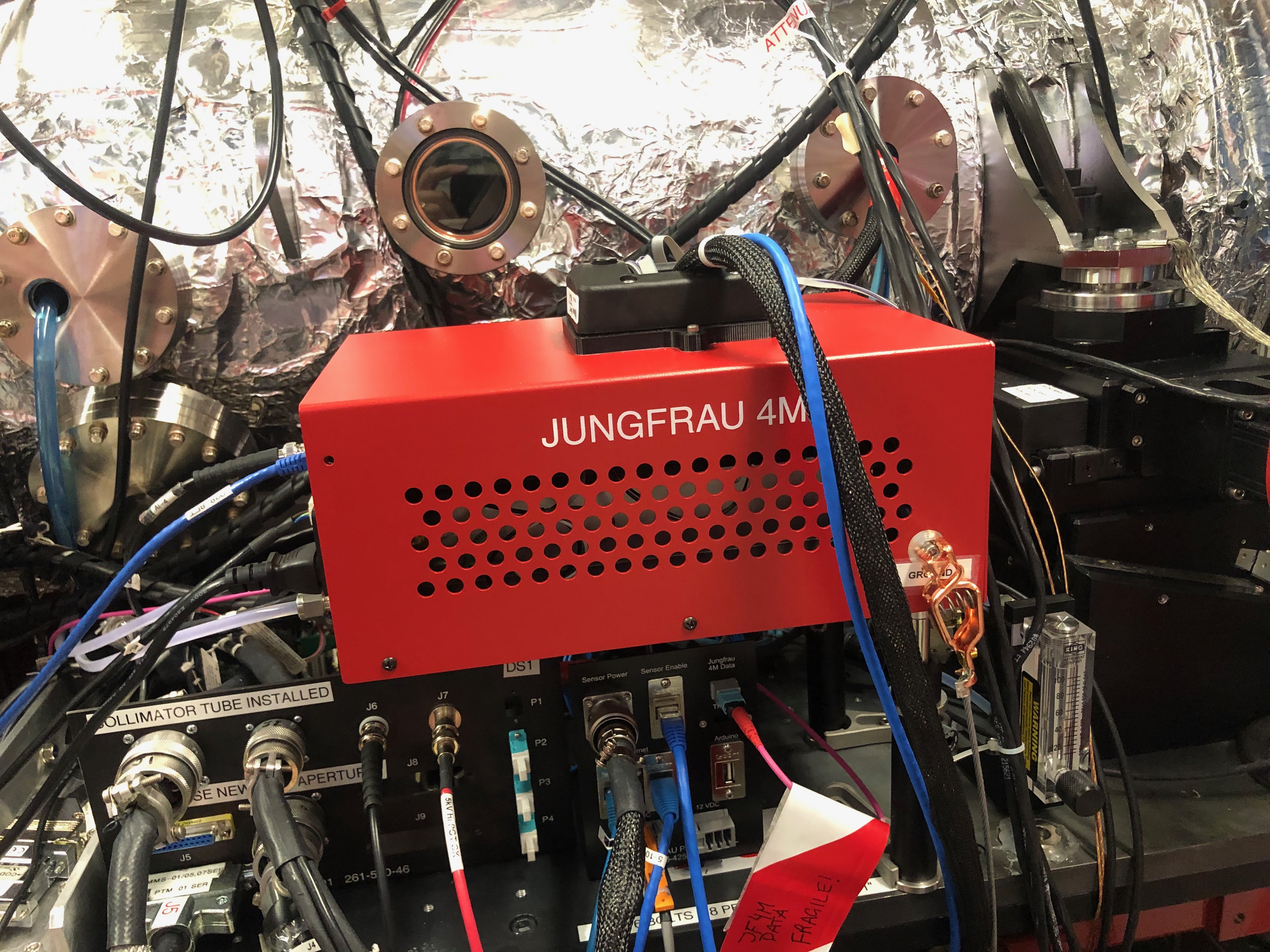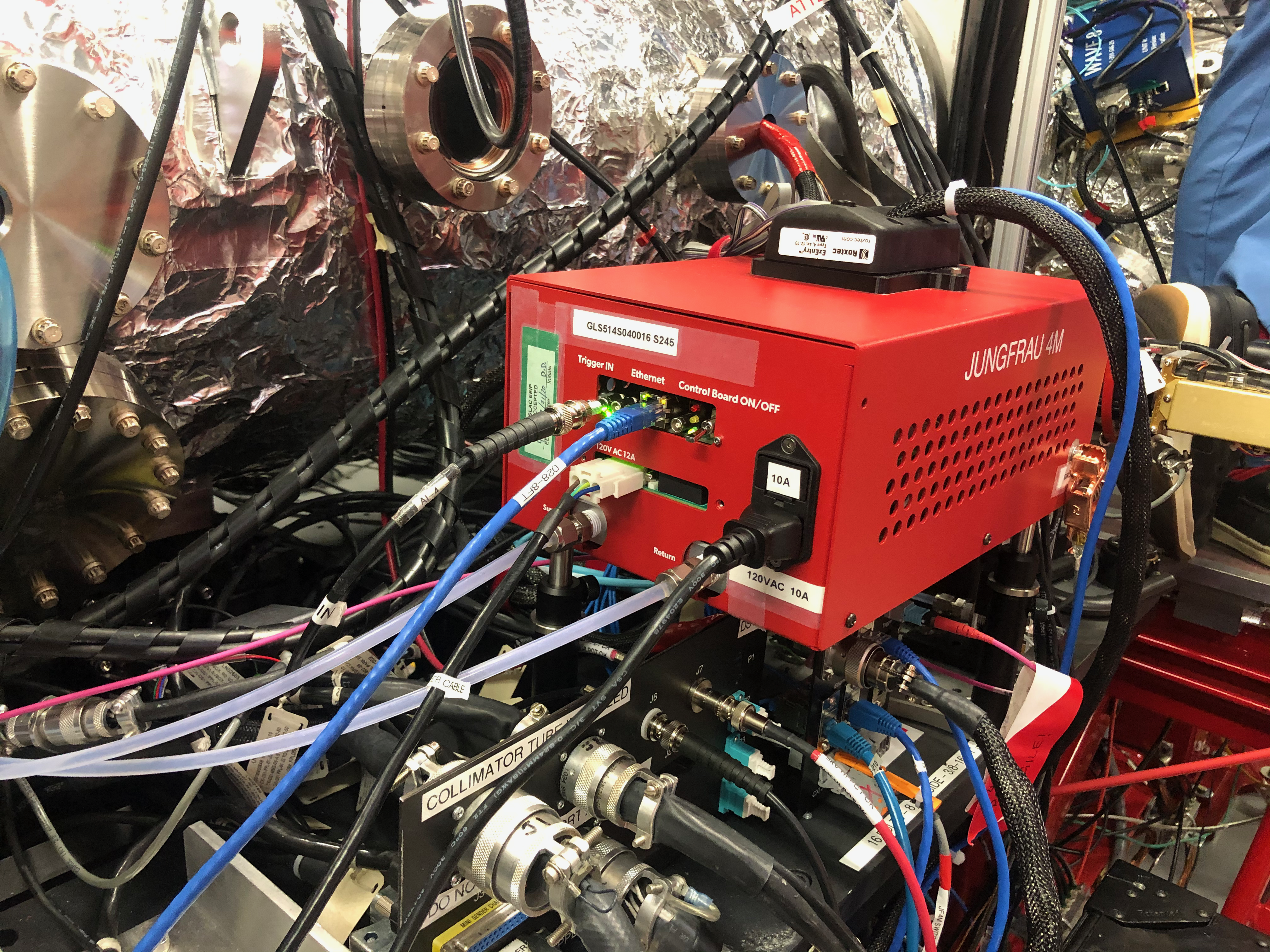Identification
Firmware | xxxx | updated date | |
|---|---|---|---|
| Module identifiers | |||
Nominal Operating Voltages and Currents
Environmental
Test conditions:
- Detector running and stabilized for two hours, nominal settings.
Record thermometer and humidity sensor readings:
Sensor Airbox T 39.64C Airbox Humidity 0.96% Airbox Pressure 1007 hPa Dewpoint -25.4C Chiller Flow 2.3 l/m Chiller Setpoint 15C
Electrical
- Document grounding scheme: Heavy clip ground wire to power supply chassis, nothing else visible:
- Read/record all available voltages and currents
Power Supply | |
|---|---|
| Temp | 29.3C |
| Voltage | 11.792V |
| Current | 25.509A |
Performance
- Force high gain mode
- Collect 1000 darks for analysis (Conny test 1; pedestals, noise, bad pixel map)
- Force medium gain
- Collect 1k darks (C2, pedestals/offsets, noise, bad pixel map)
- Force low gain
- Collect 1k darks (C3, pedestals/offsets, noise, bad pixel map)
- Create pedestals with 'makepeds -J'
- Offsets due to ambient visible light
- Viewports open/closed
- In-chamber lights
- Any laser sources planned
- Mechanical
- Verify range of motion
- Verify gate non-interference gate valve operation
- Record encoder readings for position scaling
- Assess
- If operation is nominal, move on to next block
- If time allows, vary airflow +/- 20% to check dependence
- Return gain to autoranging
1) Beam set up (12h, full shift) (wave8 monitoring throughout) (t = 0)
- No sample (60 min)
- Set max attenuation
- Pass beam through beam pipe to check alignment, systematics and baseline scatter.
- Collect 1k frames for analysis. Expect ~no signal.
- Set midrange attenuation
- Collect 1k frames for analysis.
- Set zero attenuation
- Collect 1k frames for analysis.
- Assess
- If operation is nominal, move on to next block
- If time allows consider other attenuations, moving in z
- Return to max attenuation
- Sample setting (TBD) (t = 1h)
- Set z mid-range
- Attenuator scan (1.5h)
- Assess flux level. If satisfied, continue at z-scan step. Otherwise:
- Adjust sample jet (setting B)
- Attenuator scan (1.5h)
- Assess flux level. If satisfied, continue at z-scan step. Otherwise:
- Adjust sample jet (setting C)
- Attenuator scan (1.5h)
- Assuming that we’ve got a good flux level, move to z-scan
- Set attenuator for moderate-flux level and scan in z (60 min) (t = 5.5h)
- Move detector close to sample point
- Collect 1k frames for analysis
- Move detector far from sample point
- Collect 1k frames for analysis
- At this point we believe the beam/sample are well adjusted and understood, move on to commissioning signal tests.
- Re-set to mid-range in z.
- If time allows, move on to next block early.
- High gain flats (fixed gain) (t = 6.5h)
- Set sample and choose attenuator range (30 min)
- Run attenuator scan (60min)
- Set attenuator mid-range
- Vary integration time (if this is possible) (60)
- If time allows:
i. Vary bias +/- 20%
- Medium gain flats (fixed gain) (t = 9h)
- Set sample and choose attenuator range (30 min)
- Run attenuator scan (60min)
- Set attenuator mid-range
- Vary integration time (if this is possible) (60)
- If time allows:
i. Vary bias +/- 20%
- Low gain flats (fixed gain) (t = 11.5h)
- Set sample and choose attenuator range (30 min)
- Run attenuator scan (60min)
- Set attenuator mid-range
- Vary integration time (if this is possible) (60)
- If time allows:
i. Vary bias +/- 20%
- Full range flats (autoranging) (t = 14h)
- Set sample and choose attenuator range at widest possible (30 min)
- Run attenuator scan (60min)
- Set attenuator mid-range
- Vary integration time (if this is possible) (60)
- If time allows:
i. Vary bias +/- 20%
- Repeat baseline tests (3h) (t = 17h)
- End (t = 20h)
Performance Measures
Pedestal
Method: Dark environment, nominal operation, collect 1000 frames @120Hz. Generate per-pixel mean and standard deviation over 1000 frames. Pixels more than 3 sigma out of detector-wide mean are flagged bad. Files archived as xxxxx.
Summary Values
| Date | Mean | StdDev | #Bad |
|---|---|---|---|
Pedestal Map
Noise map
Gain and uniformity (photon source)L
Linearity (signal injection)
Thermal measurements (all thermometers)
Experiment History
| Experiment | Hutch | Shifts | Date Deployed |
|---|---|---|---|
| Commissioning | MFX | 1 | 15 June 2020 |
Calibration Records
| Date | Hutch | Date | Record link | Comment |
|---|---|---|---|---|
| Commissioning | MFX | 7/29/20 | 15 June 2020 |

